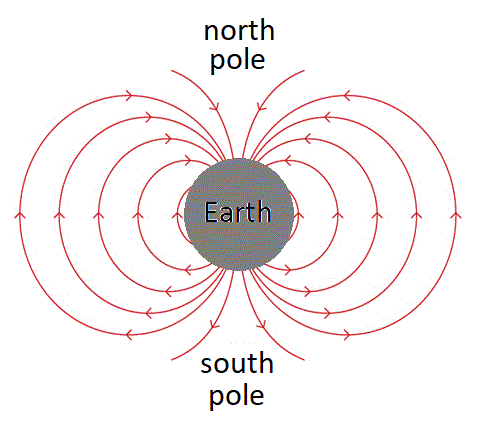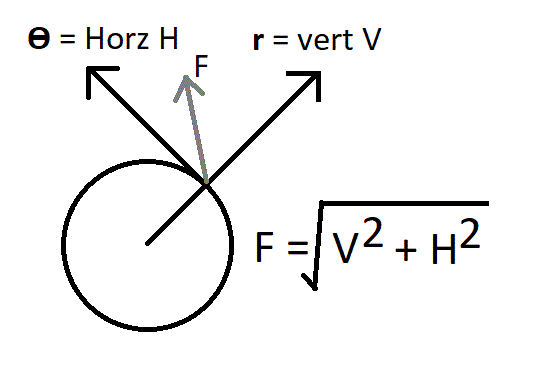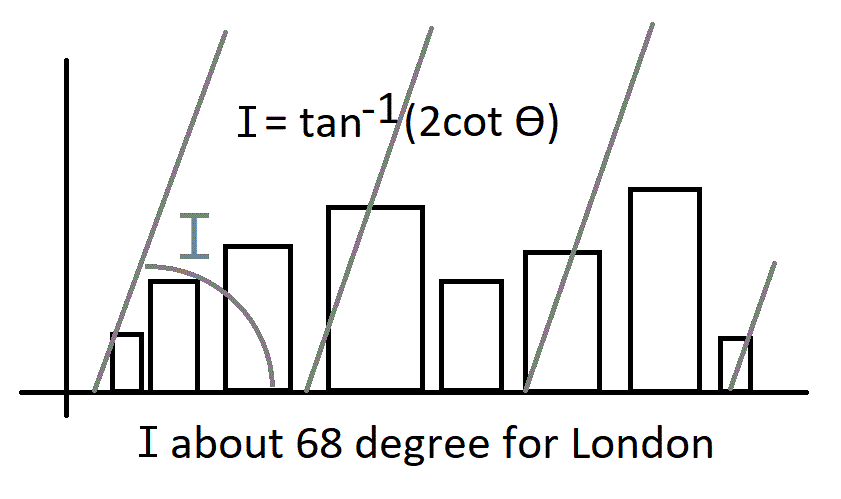**** IF YOU SPOT ANY MISTAKES OR ERRORS PLEASE LET ME KNOW ****
The Earths magnetic field - basic dipole representation

Dipole field introduction
We can learn a lot about the Earths magnetic field if we start off our theoretical investigation by making the approximation that the Earths central core is a spherical magnet. This will give us a 'first order' dipole approximation and account for much of the Earth's field that we measure on the surface.
The magnetic field of the earth is created towards the center where we believe there is a metallic core. At these depths the temperature is very high (perhaps 6000 C the temp. of the surface of the Sun) so no solid magnetic material can exist. It is believed that in this hot molten iron core, currents flow that create the field we experience on the surface. We are all familiar with its action on a compass needle for example, but the field also protects us from the constant solar plasma streaming from the Sun. During periods of high solar activity the field lines stream solar plasma into the polar regions creating the spectacular auroras.
Note 1: this analysis assumes the magnetism of the Earth is represented by a dipole but in fact the real field is more complex, this analysis is a good first-order approximation accounting for much of the field at the Earths surface. Varaitions due to solar activity, atmospheric interactions and even the Moon require more detailed analysis.
Note 2: vectors (e.g. F) and vector components (e.g. r and Θ) are printed in bold in these notes.
Dipole analysis
For this analysis we are going to assume the Earth is a uniform spherical magnet with a total magnetic moment M, where each volume element has a magnetic moment µ.dv:
M=∫µ.dv
for a sphere M=4/3 πa3µ, where a is the radius of the Earth
M = 8.07 x 1025 Gauss cm3 [1], [2]
For a magnetic potential (i.e. dipole positioned at the center of the Earth):
V = M.r/r3
V = -M cos(Θ)/r2
V = -M cos(90-L)/r2
Θ is the polar angle distribution and so L is equivalent to the geographic latitude on the Earth.
(L = 90 - Θ or Θ = 90 - L)
We can use this magnetic potential to calculate the magnetic field from:
F = -∇V
The normal rectangular x, y and z co-ordinate system does not apply itself well when used to describe physics for a spherical planet, but things become simpler if we use spherical polar co-ordinates. (Note: it may not look simplier at first but trust me it gets clearer!) .
∇V in spherical polar co-ordinates is:
∇V = dV/dr . r + 1/r dV/dΘ . Θ + 1/r sinΘ dV/dθ . θ
We assume a uniform sphere, so there is no θ dependence / variation, this simplies to:
∇V = dV/dr . r + 1/r dV/dΘ . Θ
We now see why it was worth while using spherical polar coordinates as these terms turn out to directly represent measured quantities - the horizontal and vertical components of the field as they would apear if you were standing on the surface of the Earth: the vertical component coming out of the ground vertically and the horizontal component being along the surface northward:
r is the vertical component (V), Θ is the horizontal component (H)
F = -∇V = - (dV/dr . r + 1/r dV/dΘ . Θ)
F = - {M cosΘ d/dr(1/r2) . r + M/r31/r.d/dΘ cosΘ . Θ)
F = -2M cosΘ/r3 . r - M/r3 sinΘ . Θ [1], [2]

Diagram of how r and Θ relate to V (vertical component) and
H (horizontal component) of the field on the Earth and the total field F.
which gives us the V and H components:
vertical component V = - 2M/r3 cosΘ
horizontal component H = - M/r3 sinΘ
if we define Ho = -M/a3 we get
Vertical component V = 2Ho cosΘ
horizontal component H = Ho sinΘ
The two form the components of a vector pointing along F the surface of the Earth (where you are on standing). The formula relate how the field line direction and the strength vary as we move around the Earth.
At the north pole for example, where the latitude is 90 degrees and Θ = 90-90 = 0 we get that V = -2M while H = 0, while at the equator where Θ = 90 we get V=0 and H = -M. So the analysis shows us the magnetic field strength at the poles is twice the strength found at the equator. Further to this the field lines at the pole come down vertically (no horizontal component) while at the equator they are parallel to the surface of the Earth (no vertical component).
At other latitudes the field lines will make some intermediate angle - known as the angle of dip Ι - which we can calculate by:
Ι = tan-1(V/H) = tan-1(r3 x 2M cosΘ / r3 x M sinΘ)
Ι = tan-1(2cotΘ) [1], [2]
As both the magnetic field direction and its strength vary over the Earth we can calculate what we would expect,
for example, the field strength at London will be:
So for London at latitude L = 51.5 degree we get:
Θ = 90 - 51.5 = 38.5 degree
Θ = 2 x pi x 38.5 / 360 = 0.67 radians
so the angle of dip for London:
Ι = tan-1(2cotΘ) = tan-1 (2 x 1.26)
Ι = about 68 degrees

M = 8.07 x 1025 gauss cm3
a = 6.36 x 108 cm
Ho = M / a3 = 0.314 gauss
|
1 gauss = 10-4 tesla
1uT = 1/100 gauss
1 gamma is 1-9 Tesla = 1nT
|
Notes on units
Magnetism has many different units used over the years. The table above relates some of these: gauss, Tesla, gamma (nT).
The vertical component V = 2HocosΘ = 0.49 gauss = 49uT = 49,000 gamma (nT)
The horizontal component H = HosinΘ = 0.2 gauss = 20uT = 20,000 gamma (nT)
so the total field strength will be the vector sum:
F = √ (V2 + H2) = 53uT = 53,000 gamma (nT) for latitudes such as London
Note: remember this analysis assumes the magnetism of the Earth is a simple dipole but in fact the real field is more complex so this is only a first order approximation.
Magnetic correction - D
The Earths magnetic field does not coincide exactly with the rotational axis of the Earth and also varies from year to year. Values of the difference D between the magnetic pole and celestial pole are published regularly.
A magnetometer - first tests - single hall effect detector
In the 1980's I built a hall-effect magnetometer to study the Earths magnetic field as part of my final year project for my Physics degree at Surrey University (summer 1988. [3]). A PDF of the scanned article can be found here [3]. The design used hall-effect sensors and differential amplifier. These hall effect devices were quite sensitive but suffered from poor temperature stability. I physically positioned the two sensors at 180 degrees and feed them into the inverting and non-inverting inputs of the amp so that the signals from the magnetic field would add while (ideally) the unwanted 'noise' from the temperature drift should cancel. This worked to a degree but I noticed the temperature sensitivity was not identical from one hall-effect device to another and also tended to vary over time. For about two weeks of continious measurement one of the hall-effect lost its temperature sensitivity completely (at least below the noise) and so I was able to get some quite good quality long term measurements.
1) The first tests using one of these hall effect sensors gave a reading of 275mV ± 25% when the probe was rotated 180 degree (i.e. to reverse the signal).
The sensitivity (from the RS data-sheet) was ca. 1.78 x 10-8 volt / gamma which gives a magnetic field strength of
F = 0.275/2 x 1/ 1.78 x 10-8 = 77,000 gamma ± 25% - so near!
A more sensitive design - two hall sensors and high permeability foil field magnifiers
2) I used high permeability foils to increase the field strength at the hall sensors and increase the sensitivity of the instrument. This gave about x100 increase in sensitivity over the bare Hall detectors allowing changes in field strength of XX gamma to be detected. I used the device to measure field strengths while a summer storm passed near to the equipment. This allowed an estimate of the cloud to cloud and cloud to ground lightening strikes to be made, but it also showed up hysterysis issues when using the foils [3].
References and notes
[1] S Chapman, Solar Plasma Geomagnetism and Aurora. Gorden & Breach, 1968 Lib of congress No. 64-21214
[2] S Chapman, The Earths Magnetism, Methuen's Monographs, 1961
[3] J. P. Hare, Development of a sensitive magnetometer for Solar and terrestrial investigations, final year project for a BSC in Physics Surrey University 1984-1988.
THE CREATIVE SCIENCE CENTRE
Dr Jonathan Hare, Physics Dept., The University of
Sussex
Brighton, East Sussex. BN1 9QJ.
home | diary
| whats
on | CSC
summary | latest
news



